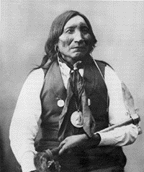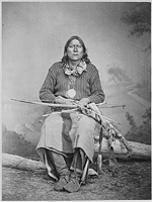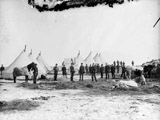
| Chief Lone |
| Wolf, Denver |
| Public Library |
BUFFALO SOLDIERS & INDIAN WARS
Part 2
July-November, 1868: Company at Ft. Arbuckle, I.T.; The company was busy during this period drilling, repairing buildings, and chasing cattle rustlers, and bootleggers. Mail delivery was especially dangerous. Murdering thieves so often attacked mail carriers, that only Indians, and soldiers dared to carry it. Private Filmore Roberts of the Tenth, showing great courage in an attempt to deliver the mail, drowned crossing the Northern Canadian River.
Background Event: Indians are denied right to vote as result of the 14th Amendment.
September 15, 1868: Arikaree Island on the Republican River; Major Forsyth and Troop I of the Tenth Cavalry with a number of scouts are attacked and surrounded by 700 Lakota and Cheyenne warriors. For eight days, they lay broiling in the sun, barely able to hold off the Indians. Fifty of their horses lay dead. To survive, they ate the rotting, blotted horseflesh. Two of the scouts crawled through the Indian lines and found Captain Carpenter and H troop a few miles away. The Indians scattered before the arrival of Carpenter and his men. Private Reuben Waller, exslave and, aide to Carpenter was amongst those participating in the rescue. Lieutenant Beecher and Dr. Moors were killed. Captain Forsyth had two wounds. Fifteen scouts had one wound each.
October, 1868: Troop I of the Tenth U.S. Cavalry, escorted Major Carr of the Fifth Cavalry, to his command on Beaver Creek. They were attacked by 500 hundred warriors. After fighting off the hostiles, they proceeded to their destination without further incident.
November 1868: Company at Fort Arbuckle, I.T.: In a show of force, Lieutenant Gray leads the entire company to Eureka Valley.
December, 1868: Company at Fort Cobb, Indian Territory; On December 1, 1868 the Company marched 96 miles from Fort Arbuckle to Fort Cobb, I.T. It remained at Fort Cobb until December 27th when it marched 60 miles to Medicine Bluff Creek, and then returned to Fort Cobb.
Background Event: General Sherman ordered Brevet Mjor General W. Hazen, Sixth Infantry, to escort the Comanches and the Kiowa from Fort Larned to Fort Cobb. After informing the tribal leaders, they failed to appear. Hazen thought they might be at Fort Cobb. When he arrived at Fort Cobb, the large size of the main bodies of the Comanches and the Kiowa with the addition of bands of Cheyennes and Arapahoes threaten the safety of his command. He immediately sent for and received the necessary reinforcements to protect his position.
January-March 1869: Company at Medicine Bluff Creek, I.T. Colonel Grierson chose this site for the new fort. The name comes from the Wichita Indian village that once stood at the location decades before. The Comanches were moved nearby. At one point, legendary warriors Chief Lone Wolf and Chief Satanta were released here on their own recognizes by General Sheridan.
Background Event: By
an Act of Congress, the 38th, 39th 40th and 41st Infantry formed into the 24th and 25th Infantry Divisions.

|
Background Event: The Central Pacific and the Union Pacific lines meet at Promontory Point, Utah. This connected the east and west coasts of the United States by rail, thus cutting the Indian lands in half. With the Trans continental railroad and the telegraph, the army could out maneuver and re-supply their troops when engaging the Indians. This significantly increased the settlement of the west and the demise of the American Indian.
June 11, 1869: Indians raided Camp Wichita, Indian Territory. Their objective was to stampede the soldier's horses. Troops A, F, H, I, and K of the Tenth U.S. Cavalry and Companies B, E and F of Third Infantry, led by Colonel Nelson, pursued the raiders. The raiding warriors turned on them, wounding three soldiers and killing six horses. Six Indians were killed and ten others were wounded.
Background Event: Newly
elected Christian Congressmen revoke the military's power to enter Indian Agencies without the Indian Agent's prior
approval. Congress appropriates $100,000 for Indian education and vocational training at Christian churches.
 |
| Chief |
| Quanah |
| Parker, |
| National |
| Archives |
October-December 1869: The Tenth U.S. Cavalry assisted settlers constructing blockhouses for their protection along the various rivers.
January 1870, Ft. Sill, I.T.: Chief Satanta
and his Kiowa warriors, stampeded about 300 head of cattle that were on a cattle drive. They also took cash and
all of the available food from the cowboys. Chief
Kicking Bird and his band of Kiowa happened along and dissuaded Satanta from killing
the cattlemen.
Background Event: Col.
Grierson makes a general inspection of the Comanche Reservation. The interaction between the factions was uneventful.
 |
| Chief |
| Satanta |
| of the Kiowa |
| ca. 1868- |
| 1874, |
| National |
| Archives |
March -April, 1870: Company at Fort Sill; Patrols were kept along Red River and were stationed at reservations during the dispersment of provisions to the Indians.
May 20-21, 1870, Kickapoo Springs, Texas; The Medal of Honor was awarded to
Sergeant Emanuel Stance, Ninth U.S. Cavalry, Troop F. He was the first Buffalo Soldier to receive this honor.
Sergeant Emanuel Stance and twelve troopers, while looking for two captured children, attacked a band of Indians
herding stolen horses. He immediately gave the order to charge, scattering the Indians and capturing the horses.
His troop, still heading for Kickapoo Springs, camped for the night. In the morning, Sgt. Stance spotted twenty
Indians preparing to attack a wagon train. His troop charged the war party with carbines blazing, routing the warriors
and capturing six more ponies. Later, while watering their horses at a spring, his men were attacked by the Indians.
This time his let his men loose to do what they may. The Indians retreated in a frenzy of fear. Sergeant Emanuel
and his little troop proceeded on their way and recovered the two captured white children.

|
 |
| 9th Cavalry at |
| Wounded Knee. |
| Buffalo Soldiers |
| were not involved |
| in massacres. Afro- |
| Americans with |
| horse in |
| background 1889- |
| 1891. ca. Denver |
| Public Library |
October-December: Malaria, typhoid, and fatal dietary deficiencies, killed twelve troopers and and reduced the general effectiveness of the regiment.
January 24, 1871: Comanches attack and kill the black frontiersman Britton Brit Johnson and two other black cowboys while hauling supplies. Johnson, in the past, had recovered Indian captives and was known as one of the best shots around. He was a friend to the troopers and was once a friend of the very same Indians who slew him. See African-American links page 5.
March 1871: Cache Creek at Red River; Troops L and
M of the Tenth scout for war parties who have consistently struck at the settlers. Their efforts were fruitless.

|
May, 1871: Company at Camp Wichita, I T.; General
Sherman escorted by the Tenth U.S. Cavalry, inspects
Fort Griffin, Ft. McKavett,
Ft. Concho and Fort Sill. He heard about Satanta and the Red River killing of seven settlers, and the theft of
forty-one mules. A trap was set for Satanta at Fort Sill. After responding to an invitation to come to the fort,
Satanta publicly describes the deeds to General Sherman and Grierson. Chief's Satank, Big Bow, Lone Wolf , and
Chief Satanta, were arrested on the spot by Troop D of the Tenth, who came out of hiding with carbines and pistols
at the ready. Lone Wolf , wearing a blanket, uncovered a concealed rifle and pointed it at General Sherman. Sherman
was alert enough to pull the weapon out of Lone Wolf's hands before he fired. Big tree then made an unsuccessful
attempt to escape. In the meantime, hundreds of Indians already at the reservation fled into the hills. Days later,
they returned starving. One Indian was killed with Private Hampton of Troop D wounded.
| Above: Satank or Sitting Bear, Kiowa chief of the Society of the Ten Bravest ca.1868-1869. At age 69, he was still leading raids into Texas. National Archives. Right: Zepko-etteinto or Big Bow, Kiowa Chief, descended from a line of prominent war chiefs. Smithsonian Institute. |
Indian Territory, ca.1871:
Dispersment of provisions at Camp Supply
| Send e-mail to: sldavis@buffalosoldier.net |
| Copyright 1999 Stanford L. Davis, M.A. |
| All Rights Reserved |
| www.buffalosoldier.net |